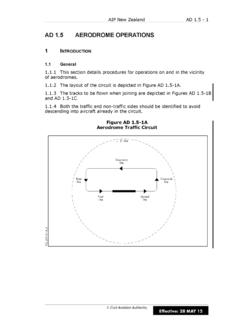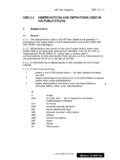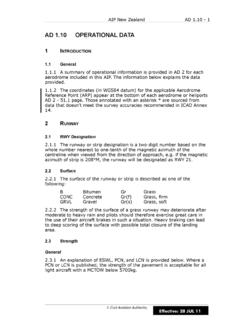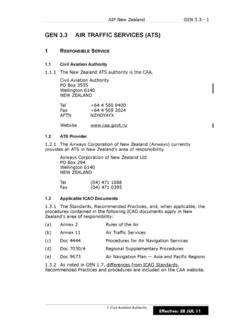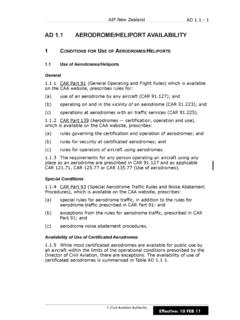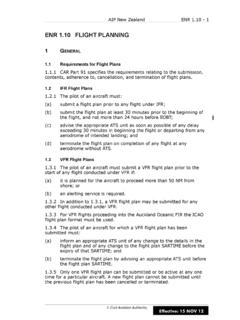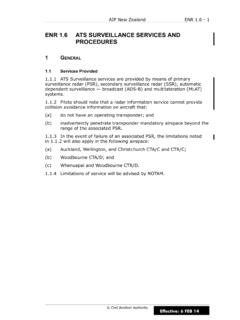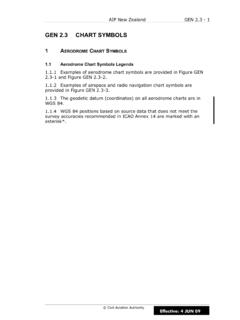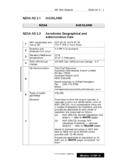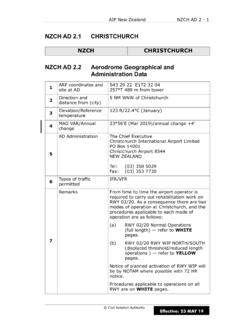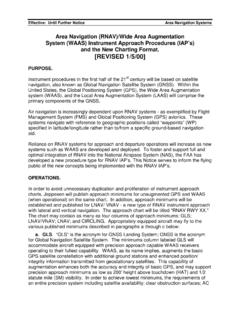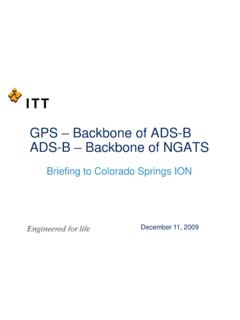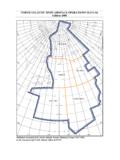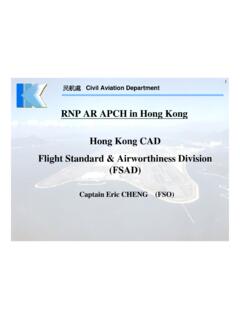Transcription of 1G ENERAL 1.1 Use of PANS-OPS 1.2 Significant Differences ...
1 ENR - 1 AIP New Zealand Civil Aviation AuthorityENR DEPARTURE, HOLDING, AND Use of Instrument holding, approach, and departure procedures inNew Zealand are designed using criteria contained in ICAO Doc 8168 PANS-OPS VOL PANS-OPS stresses the need for flight crew and operationalpersonnel to adhere strictly to the published procedures in order to achieveand maintain an acceptable level of safety in Significant Differences from ICAO Doc 8168 PANS-OPSNon-Standard Approach At a limited number of locations in New Zealand, the terrain orexisting NAVAID infrastructure necessitated promulgation of instrumentapproach procedures which are primarily designed to enable the flight crewto establish the visual references necessary to continue on a visualapproach, or to proceed to the aerodrome of landing under VFR, Although the minima for these approaches are annotated on AIPcharts as circling , these approaches do not utilise the standard circlingareas or standard circling manoeuvring.
2 These approaches aredistinguished from standard PANS-OPS circling approaches by a note belowthe landing minima box on the approach chart stating the approaches are:OGreat Barrier (NZGB): NDB A, RNAV (GNSS) BOQueenstown (NZQN): VOR/DME B, VOR/DME C, RNAV (GNSS) F,RNAV (GNSS) GEffective: 21 JUL 16 DENR - 2 AIP New Zealand Civil Aviation Containment Within Controlled Controlled airspace may not totally contain the navigationaltolerances associated with holding,approach, and departure proceduresat controlled Airspace is designed to contain arrivals based on a 5% descentgradient. When higher gradients are required, altitude constraints will bepublished to ensure airspace Airspace containment for approaches is based on the approachgradient or 5% where there is no stated Minimum altitudes specified on DME ARCs and holding proceduresprovide terrain and obstacle clearance, but do not ensure flight is containedwithin controlled Published minimum climb gradients (PDG) on instrument departuresprovide required obstacle clearancebut do not ensure controlled For departure procedures at Auckland, Wellington and Christchurchan advisory climb gradient for controlled airspace containment will bestated where this is higher than the obstacle clearance Where controlled airspace containment has been assessed for adeparture procedure at an aerodrome other than Auckland, Wellington orChristchurch, it will only include an advisory climb gradient where a climbgradient higher than 5% is required, as a 5% climb gradient is used toevaluate airspace containment Published minimum climb gradients on a dedicated Radar SID willensure both required obstacle clearance and containment within controlledairspace until the commencement of radar vectoring.
3 During radarvectoring, controlled airspace containment and adequate obstacleclearance will be ensured by radar For a missed approach procedure, airspace containment is based onthe assumption that a 5% climb gradient can be achieved and the altitude given in the missed approach instructions cannot be reached,aircraft are to climb in the hold and at controlled aerodromes, the pilot is toadvise : 26 MAY 16 ENR - 3 AIP New Zealand Civil Aviation Performance Based Navigation (PBN) The following ICAO PBN specifications have been implemented inNew Zealand FIR (NZZC) in accordance with ICAO Doc 9613 PBNM anual:(a) RNAV 1 specification for STAR at Auckland, Wellington andChristchurch;(b) RNAV 2 specification for all RNAV enroute operations;(c) RNP 1 specification for SID and STAR at selected regionalaerodromes;(d) RNP Approach (RNP APCH) specification at selected applies to approaches titled RNAV (GNSS); and(e) RNP Authorisation Required (RNP AR) specification at selectedaerodromes.
4 This applies to approaches titled RNAV (RNP).Note: RNAV (RNP) approach and departure procedures at QueenstownAerodrome (NZQN) are not designed in accordance with ICAO RNP The following navigation systems are supporting PBN applications inNZZC:(a) GNSS navigation systems all PBN specifications.(b) FMS with DME/DME/IRU sensor inputs RNAV 1 SID and STAR unless otherwise stated on chart, and selected RNAV 2 : Refer to ENR Table for the list of RNAV 2 ATS routes availableto DME/DME/IRU equipped Navigation systems with DME/DME sensor inputs only, do notsupport PBN application in NZZC unless otherwise stated on All pilots are required to maintain route centrelines, as depicted byon-board lateral deviation indicators and/or flight guidance, unlessauthorised to deviate by ATC or under emergency For normal operations, cross-track error/deviation (the differencebetween the RNAV system-computed path and the aircraft position relativeto the path) should be limited to +/- the navigation accuracy associatedwith the procedure or route ( for RNP 1, maximum deviation is ).
5 Brief deviations from this standard during and immediately afterprocedure/route turns, up to a maximum of one-times the navigationaccuracy ( 1 NM for RNP 1), are : 26 MAY 16 ENR - 4 AIP New Zealand Civil Aviation CAA Operator approval is required for most PBN operations withinNZZC. CAA Advisory Circular AC 91-21 details the requirements for alloperators for an operational approval to conduct PBN operations. AC 91-21is available at CAA web site Aircraft with existing GPS IFR Terminal Approvals and fitted withequipment listed in AC91-21 Table FAA AC 90-100A Non-CompliantEquipment cannot fly RNAV 1 ATC Speed and Altitude Speed and altitude constraints required for air traffic managementthat are incorporated into instrument flight procedures will be preceded bythe symbol . This differentiates ATC restrictions from those constraintsthat are inherent in the design of the instrument flight procedure. Eachelement will be annotated separately. These ATC restrictions may beamended or cancelled by ATC in accordance with their The annotated ATC restrictions can be seen on those applicableinstrument procedure charts that have been reissued, or new charts issued,from 26 MAY IFR Departure Published departure proceduresprovide routing to avoid most highterrain that may be in relatively close proximity to the aerodrome.
6 Wherethis is not possible minimum set heading altitudes or visual segments willbe prescribed. In emergency circumstances terrain clearance cannot beguaranteed under all conditions of operation, due to aircraft In accordance with PANS-OPS , Vol II, the promulgated departureprocedure design gradient may not take into account close-in obstacleswith height of 60 m (200 ft) or less above departure end of runway (DER).At locations where such obstacles exist, a cautionary note, includingobstacle position and height, is provided as part of the The pilot must consider the one engine inoperative climbperformance of the aircraft in relation to the height of terrain over the pilot must establish before departure that, in the event ofengine failure prior to reaching MSA, or the level acceleration altitude,adequate action can be taken to protect the aircraft. This action willnormally involve a return towards the departure aid until either MSA isreached or approval is granted to re-join for approach and landing; in thisrespect the pilot must take into consideration the terrain over which areversal turn may have to be : 26 MAY 16 ENR - 5 AIP New Zealand Civil Aviation Departure procedures may consist of one or more of the following:(a) a published instrument departure procedure;(b) a climb on track above enroute descent (distance) or VORSEC chartsteps, when each designated step is to be crossed at an altitude ofat least the next step minimum altitude;(c) a specified track, radar heading or radar SID or heading within anevaluatedclimbsector;(d) departure instructions containing an initial altitude restriction whenradar control is being exercised.
7 Pilots can expect to receive anamended clearance to climb when clear of conflicting traffic;(e) a visual departure by day only, having due regard to prevailing METconditions, a departure maintaining terrain clearance visually toapplicable MSA (including enroute descent (distance) or VORSEC chart steps) or specified upper limit or set heading point or heading and minimum crossing altitudes are based on a MNMnet climb gradient of unless higher stated while maintainingenroute clearances.(f) departure instructions containing a visual departure segment maybe flown only during the procedure containing a visual departure segment may beconsidered for application at night following a separate : Departure procedures with a visual departure segmentapproved to be flown at night will be so annotated on the If a secondary or grass runway with a promulgated IFR take-offminimum is not included in the departure procedure for an aerodrome, thepilot may take-off from that runway by day only provided:(a) the pilot maintains terrain clearance visually until established on apromulgated departure procedure for that aerodrome; and(b) the aircraft maintains an adequate climb gradient to ensure Aircraft are to intercept the specified departure track by the shortestpractical means after completing the turn after take-off.
8 The direction ofturn is as published or as instructed by Where climb to a minimum altitude is required in the departureprocedure, ATC may require a climb to a higher altitude for trafficmanagement, provided mandatory climb and turn requirements are : 10 NOV 16 ENR - 6 AIP New Zealand Civil Aviation Aircraft on a visual departure may be required to route viaprominent geographical features, landmarks, visual reporting points orCTA/CTR sectors in order to achieve geographical separation. VisualNavigation Charts or an electronic equivalent should be Where no published instrument departure procedure is promulgatedfor a route, the pilot is to ensure that, when flying the other departureoptions available as in para , the climb performance of the aircraft isadequate to provide obstacle clearance prior to reaching minimum A rate of climb table is provided in Table ENR to assist pilots inassessing and monitoring climb requirements under known or approximategroundspeed Departure instructions from ATC or the departure procedure flownby a pilot may include a specific track or heading within an evaluated climbsector, which may be within a sectorlimited by radials and/or tracks, Unless otherwise specified aircraft are to:(a) maintain from take-off the climb gradient as required by thedeparture procedure for the track being flown.
9 And(b) climb on departure to MNM 400 ft (or higher altitude if specified)above aerodrome level before commencing a turn to intercept trackor Where an aircraft is required to cross through two or more sectorsto intercept the departure track, the higher climb gradient required appliesfrom Where a departure requires an aircraft to climb via the radial ortrack dividing two sectors with different climb gradients, one of which maybe the standard climb sector, aircraft need only comply with thelower sector gradient Prior to leaving an evaluated climb sector the aircraft must be:(a) established on an evaluated route; or(b) established on a climb above VORSEC steps; or(c) established under radar control at or above minimum radar terraincontour level; or(d) at or above an approved area : 10 NOV 16 ENR - 7 AIP New Zealand Civil Aviation AuthorityTable ENR Take-Off Procedure Rate of ClimbThis rate of climb table is provided for use in planning and executingtake-off procedures under known or approximate groundspeed SPEED (KNOTS)ft/NMpercent%30608090100120140150 180210240270300 SPEED (KNOTS) of climb required VSI (ft/min) = Gradient percent x Groundspeed (kt) x percent* = VSI (ft/min)Ground speed (kt) x per nautical mile (ft/NM) = VSI (ft/min) x 60 Ground speed (kt)* An approximate method is to divide rate of climb by groundspeed in will give an accurate answer to one decimal place for gradients up to4%, and for gradients up to 12% apply a correcting factor of minus : 15 NOV 12 ENR - 8 AIP New Zealand Civil Aviation AuthorityEffective.
10 15 NOV 12 ENR - 9 AIP New Zealand Civil Aviation Published Instrument Departure Published instrument departure procedures consist of StandardInstrument Departures (SID) and departure procedures included in , which are used to standardise departure instructions, reduce RTFcongestion and the chance of error in aircraft routing, and provide positiverouting for aircraft suffering communications The SID specifies in both diagrammatic and narrative form any ofthe following: the direction of turn, headings,track,distances,significantpoin ts and altitude requirements. Where tracking to or from a navigationaid is not possible, desired tracks are shown and due allowance for wind isto be made. Aircraft are to continue climbing throughout the SID unless incompliance with published ATC altitude restrictions, segment MSA or asotherwise SID are identified by one or more of the following: departurerunway, direction of turn, route of the SID, Significant point associated withthe SID, a validity number and a route SID may also include transitions.
